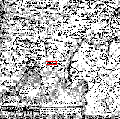| |

Speed's
1610 map of Staffordshire

Coffins 14 & 15 in Trench 1

Coffins 19 & 20 in Trench 1 |
|
|
As part of the construction of a new bus interchange an
archaeological watching brief was maintained on the
excavation of a sewer trench in the area of the abandoned
graveyard of the former church of St Nicholas, Oldbury.
The graveyard was in use from possibly as early as 1529
when the church was built. Certainly there were burial by
1706 and the site continued as a place of burial until
the middle of the 19th century. Twenty burials or parts
of burials were identified and their locations recorded.
As human remains are particularly sensitive, not simply
archaeologically, but also in an ethical sense,
discussions were held with the client, Sandwell
Metropolitan Borough Council, to determine the best
outcome. Fortunately, it was possible to design the
groundworks in such a way that the burials were not
excavated or disturbed in any way, except what was
necessary to clean and define the uppermost part of the
coffins. Most of the coffins were simple plank-built
constructions with no coffin plates or other furniture,
but one brick lined grave and a brick crypt were also
found. The graves are fairly well spaced, except those
buried in close groups which may represent family plots.
It is likely that the church itself was demolished to
ground level and that the foundations still survive,
probably just below the current pavement deposits. It was
not seen in the excavation for the sewer trench and was
not disturbed by other works.
A continuation of the watching brief located parts of the
graveyard walls, other graves to the south, a building
wall dating to the 18th century and a cellar vault from
the former Talbot Hotel.
In combination with the historic maps the present work
has helped to define the limits of the graveyard and
establish the depth of the burials. It has shown that
buried archaeology relating to the buildings that stood
in the southern part of the Civic Square still survives.
The watching brief continued into Freeth Street where it
was apparent that there is unlikely to be medieval
archaeology, but the possibility of prehistoric
archaeology in this area remains unknown.
|



